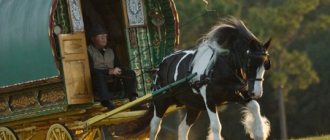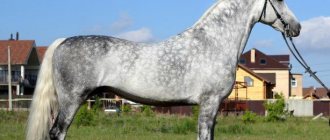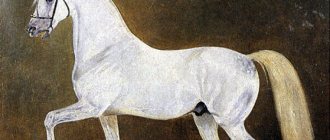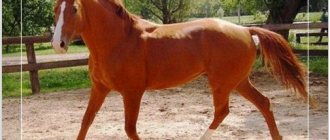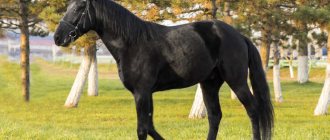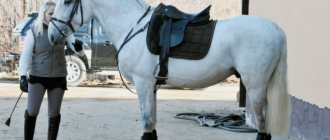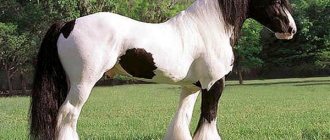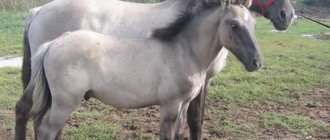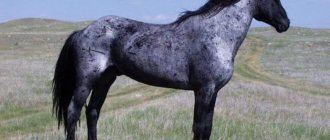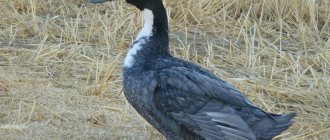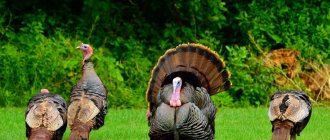The homeland of the Clydesdale horse breed is Scotland. These animals, belonging to the heavy draft variety, are rightly called giants. The weight of a horse can reach 1 ton. Therefore, today these horses continue to be used in heavy agricultural work and for transporting goods.
Horses carry a heavy load
Clydesdale with white mane and tail
Horse grazing
Graceful horse
Clydesdale mare and foal
Horse with white legs
Draft horse
Young horse runs
Clydesdale runs across the steppe
Clydesdale horse
History of the breed
Strong and hardy horses existed in Scotland back in the Middle Ages. However, at the beginning of the 18th century. Duke Hamilton IV came up with the idea of improving the exterior and working qualities of local horses. To do this, he crossed Scottish mares with Flemish stallions, which were brought from Holland.
As a result of this selection work, the number of Scottish horses has become larger. The animals acquired not only endurance, but also good health. The updated type of horses was also appreciated by the local population. The Scots were willing to pay for the mating of their mares with thoroughbred stallions from the continent.
Gradually, the Clydesdale breed gained popularity outside of Scotland. Animals began to be actively exported to European countries. In 1878, a stud book was established for Clydesdale horses. Other English heavy draft horses, the Shires, also contributed to the development of this breed. Their participation in breeding work made it possible to make Scottish draft horses even larger and more powerful.
At the turn of the XVIII-XIX centuries. More than 20,000 Clydesdale horses were exported outside the country, so much did the demand for strong and graceful horses grow. The best representatives of the species were sent not only to European states. Animals were actively exported to the United States, Canada and even Australia. Abroad, the Clydesdale horse was used to increase the number of its breed, and also participated in selection work on other breed lines.
After World War I, the Clydesdale population declined greatly as these massive and powerful animals were used by the army. The restoration of the population was also hampered by rapid technological progress. Horsepower was replaced by machines in agriculture. They easily coped with the hardest work, so interest in draft horses quickly disappeared. They began to be seen only as a source of meat.
In the 20th century The number of these horses has sharply decreased, and the Clydesdale horse breed was added to the list of endangered species. The joint efforts of breeders and the state made it possible to preserve this species as a historical value of Scotland.
Lifestyle in nature
To successfully breed the Clydesdale breed, it is important to understand what affects the condition of horses in nature:
- Animals need fresh air. In unfavorable conditions, the horses' immunity will weaken. The optimal ambient temperature for keeping heavy trucks is 15 °C.
- High humidity leads to diseases.
- Sunlight is vital for giants. Ultraviolet rays help fight microbes, absorb vitamins and activate physiological processes. But extreme heat can lead to heatstroke. Therefore, it is important to organize shaded areas for relaxation in hot weather.
- It is easier for Clydesdale horses to go without food, but they need to drink plenty of fluids regularly.
See also
Description and characteristics of Holstein horses, maintenance rules and priceRead
The combination of all factors will have a beneficial effect on animal health.
Exterior and color
Despite their large dimensions, horses of this breed are distinguished by a harmonious physique. The height of stallions can reach 1.83 m, and their weight is about 1000 kg.
The Clydesdale breed is distinguished by its attractive appearance. Animals can be recognized by their large, elongated head with a wide forehead, widened nostrils and expressive eyes. The large and muscular body is shortened, the legs are massive and straight, with lush friezes. The hooves have the correct shape. The hair of the mane and tail is thick and long.
The color of representatives of this species is predominantly roan, red or bay, often there are spots on the body of the animal. The gray color for the Clydesdale breed is considered rare.
Clydesdale
Clydesdale
Clydesdale
- Great Britain
Media files on Wikimedia Commons
A pair of Clydesdales in harness. Clydesdales in harness, Boston.
Clydesdale (Clydesdale, Scottish cold-blooded horse) (English Clydesdale, IPA (English): /ˈklaɪdzdeɪl/) is a breed of horse, descended from working mares from Clydesdale, Flemish and Dutch stallions. Somewhat smaller than the Shire, but more homogeneous and cultured. The color is bay and karak. Bald head and stockings, like a Shire. The girth in the girth reaches a fathom. The weak point of almost all heavy trucks is their legs. The uniformity and culture of this breed is the result of appropriate education and selection. Foals and youngsters enjoy sufficient movement and a variety of food, which is why an adult horse is drier than other draft horses and has a uniform and fast pace. Thanks to their qualities, Clydesdales spread everywhere with amazing speed over the last quarter of the 19th century. In England itself they are often bred mixed with shires; Such mestizos are not much inferior to purebred Clydesdales. Clydesdales are usually used to cover trotting mares, half-breds from other heavy draft horses, and generally larger horses.
Originally it was one of the small draft breeds, now it is a tall breed.
The breed was originally bred and used for agricultural purposes and for harnessing, and is still used for the same purposes. Some representatives of the breed are used as drum horses for the British cavalry. They were also used to create and improve other breeds.
Character
Despite their large size, Clydesdale horses demonstrate calmness and a good-natured disposition. Strong and hardy animals willingly do any hard work without showing their temper to the owner. A distinctive feature of the breed is the rapid maturation of foals, which is not characteristic of all heavy draft breeds.
Breeders often call these animals phlegmatic. Clydesdale horses become very attached to their owner and become his devoted companion. Horses are ready to adapt even to harsh climates. In return, they need to be provided with a warm stall, good care and good nutrition.
Further reading[edit]
- Biddell, Herman (1894). Draft Horses: Breeds and Management. London, Vinton and Co.
- Dutson, Judith (2005). Storey's Illustrated Guide to the 96 Horse Breeds of North America
. Storey Publishing. ISBN 1-58017-613-5. - Edwards, Alvin Hartley (1994). Encyclopedia of the Horse
(1st American ed.). New York: Dorling Kindersley. ISBN 1-56458-614-6. - Hayes, Captain M. Horace, FRCVS (2003) [1969]. Horse Spectacles
(7th Revised Edition). New York: ISBN Arco Publishing Company, Inc. 978-1-59333-000-2.CS1 maint: multiple names: list of authors (link) - Hendricks, Bonnie (2007). International Encyclopedia of Horse Breeds
. University of Oklahoma Press. ISBN 978-0-8061-3884-8. - McNeilage, Arch. (1904). "Scottish authority on the bonus system". In National Livestock Association of Canada (ed.). General Agreement Questions 1–3
. State Press Bureau. - Smith, Donna Campbell (2007). The Draft Horse Book: The Gentle Giants Who Built the World. Globe Pequot. ISBN 978-1-59228-979-0.
Breed today
Representatives of this breed are valued for their good disposition, incredible performance and bright appearance. Heavy horses are also ready to demonstrate their aristocracy and lightness of gait. Clydesdale horses often participate in ceremonial demonstrations, rides of the nobility or royal guards.
In addition, animals continue to work in agriculture. Their strength and endurance remain in demand where technology cannot be used. For example, in mountains or forests. Horses of this breed are actively involved in breeding work. Their blood helped create many of the horse breeds popular today.
Use of Clydesdale horses
The peak population of the Clydesdale horse breed occurred in the 18th century, at the time of the development of coal mining in the Lanarkshire basin. Due to the urgent need for mass transportation of heavy loads, people began to breed a new breed of horses and develop Clydesdale draft horses for coal mining. In addition, Clydesdales became indispensable in agricultural work in Scotland, after which they were used in this area in other cities and countries.
After the population of this breed, horses began to be purchased en masse by famous horse breeders and breeders to develop new breeds. The main merits of this breed are that they were bred as a universal heavy riding horse and horses for sports, in particular for show jumping. Today, Clydesdale heroes are exported all over the world.
Maintenance and nutrition
Being hardy and efficient, animals of this heavy draft breed are the most demanding in terms of climate and living conditions. The damp climate causes them frequent respiratory diseases. In the stable where the horses are kept, it is necessary to install a thermometer and monitor the air temperature. It should not fall below +5ºC. In cold climates, the stables are insulated and heated. Animals easily tolerate dry air, but increased humidity negatively affects horse health.
The Clydesdale is a horse that requires a spacious stall with a window. The floor in the stall must be warm and dry; for this it is covered with a layer of sawdust and straw. The horse needs long walks every day. Working animals have their hooves examined after heavy exercise and cleaned if necessary.
The sun's rays help horses maintain good immunity, so horses must be taken out of the stable in sunny weather. However, heat stroke should be avoided. At noon, especially on hot days, the horses are taken to the shade.
During the summer months, it is recommended to bathe horses twice a week using a stream of water from a hose. The mane and tail must be washed with a special shampoo. After bathing, the animal's fur is wiped dry, the hair of the mane and tail is untangled and combed with a large comb.
An adult horse drinks up to 70 liters of water daily. Fluid intake depends on the weather, the quality of the feed and the intensity of physical work. It should be remembered that a hot animal cannot be given water immediately after exercise. You should offer him water an hour after hard work. During this time, the horse will have time to rest and cool down.
In the summer, Clydesdale horses are fed fresh greens; in the cold season, the basis of their diet is hay. The daily menu also includes grains, various vegetables and fruits, and a small amount of sugar. Vitamin and mineral nutrition is provided by special concentrates and additives.
Clydesdale care
Clydesdales need extra care. First, they take longer to care for simply because of their size. Additionally, the hair on their feet needs to be shampooed regularly to remove dirt and debris, and it needs to be completely dried to prevent skin irritation. Clydesdales also require daily inspection and cleaning of their large hooves and require much larger shoes than normal.
pros
- Smart
- Calm disposition
- Easy to learn
Minuses
- Requires additional care
- More expensive to own than an average sized horse
Interesting Facts
The history of the Clydesdale horse breed is not so long, but during this time the animals were on the verge of extinction more than once. The species was preserved only thanks to the efforts of Scottish and English breeders.
The current population of these animals is no more than 5,000 horses. At the same time, most of the horses of this breed ended up outside the UK. Their stock is supported by breeders from the United States and Canada. In these countries, heavy draft animals continue to be used for agricultural work.
Clydesdale horses are considered native not only to Scotland, but also to New Zealand. This explains the great popularity of this breed on the Australian continent, where Clydesdale horses occupy the top lines in all sorts of popularity ratings.
Links[edit]
| Wikimedia Commons has media related to Clydesdale . |
- Barbara Riszkowski, D. Pilling (eds.) (2007). List of breeds documented in the Global Animal Genetic Resources Databank, an appendix to The State of the World's Animal Genetic Resources for Food and Agriculture. Rome: Food and Agriculture Organization of the United Nations. ISBN 9789251057629. As of January 2022
- ^ abcde Breed passport: Clydesdale / Great Britain (Horse). Food and Agriculture Organization of the United Nations Domestic Animal Diversity Information System. As of April 2022
- Horse Watch List. Trust in the survival of rare breeds. As of April 2022
- ^ ab Valerie Porter, Lawrence Alderson, Stephen J. G. Hall, D. Phillip Sponenberg (2016). Mason's World Encyclopedia of Breeds and Livestock Breeding (Sixth Edition). Wallingford: CABI. ISBN 9781780647944.
- Elisa Rousseau, Yann Le Bris, Teresa Lavender Fagan (2017). Horses of the world. Princeton: Princeton University Press. ISBN 9780691167206.
- ^ abc Alvin Hartley Edwards (2016). Encyclopedia of Horses
. New York, NY: DK Publishing. ISBN 9781465451439. - ^ abcd "Clydesdale". International Horse Museum. Retrieved September 4, 2013.
- ^ abcde "History of the breed". Clydesdale Horse Society. Archived from the original on September 9, 2013. Retrieved September 4, 2013.
- ^ ab Hendricks, pp. 133–134
- Biddell, pp. 75-76
- McNeilage, page 73
- ^ abc Edwards, pp. 284–285
- ^ abcdefghi Dutson, pp. 348–351.
- ^ab "Watchlist". Trust in the survival of rare breeds. Archived from the original on March 24, 2009. Retrieved January 24, 2011.
- "Our goal" . Commonwealth Clydesdale Horses. Archived from the original on February 19, 2011. Retrieved January 25, 2011.
- "Our History - 1900-1930". Commonwealth Clydesdale Horses. Archived from the original on February 19, 2011. Retrieved January 25, 2011.
- Jump up
↑ Hayes, p. 361 - "Our history - from 1970 to the present". Commonwealth Clydesdale Horses. Archived from the original on February 19, 2011. Retrieved January 25, 2011.
- "Watchlist - Horses". Trust in the survival of rare breeds. Archived from the original on August 25, 2011. Retrieved January 24, 2011.
- "Conservation of Priority Horse Breeds 2010" (PDF). Conservation of American Livestock Breeds. Retrieved January 24, 2011.
- "Clydesdale horse". Conservation of American Livestock Breeds. Retrieved January 31, 2011.
- "Clydesdale Horse - Breed Standards". Commonwealth Clydesdale Horses. Archived from the original on February 19, 2011. Retrieved February 11, 2011.
- "Chronic progressive lymphedema (CPL) in draft horses". University of California at Davis. Archived from the original on February 3, 2013. Retrieved May 22, 2010.
- "Archival copy". Archived from the original on August 7, 2017. Retrieved April 6, 2022.CS1 maint: archived copy as title (link)
- ^ ab "Sabino spotting". American Paint Horse Association. Archived from the original on August 31, 2013. Retrieved September 4, 2013.
- Brooks, Samantha; Ernest Bailey (2005). "Exon skipping in the KIT gene causes spotting in horses." Mammalian genome
.
16
(11): 893–902. DOI: 10.1007/s00335-005-2472-у. PMID 16284805. S2CID 32782072. - ↑
Roy, Bruce (August 16, 2010).
"Stable Conversation". Project equestrian magazine
. Archived from the original on December 24, 2012. Retrieved February 11, 2011. - "Modern Clydesdale". Clydesdale Horse Society. Archived from the original on February 3, 2015. Retrieved January 25, 2011.
- ^
Reid, Melanie (31 March 2010), "Digger, the horse who grew up to join the army",
The Sunday Times
, retrieved 24 January 2011. - "Drum Horse". Household cavalry. Archived from the original on May 17, 2009. Retrieved February 3, 2011.
- ↑
Edwards, pp. 374–375 - Dutson, pp. 117-118
- "The basis of the breed". Clydesdale & Heavy Horse Field Days Association Inc. Archived from the original on July 11, 2011. Retrieved January 25, 2011.
- Dutson, page 294
External links [edit]
- Clydesdale Horse Society
- Clydesdale Breeders USA
- Clydesdale Horse Society
- Clydesdale Horse Association of Canada
| vtehorses of the British Isles breed | |
| Horses |
|
| Pony |
|
| Types |
|
| Extinct |
|
